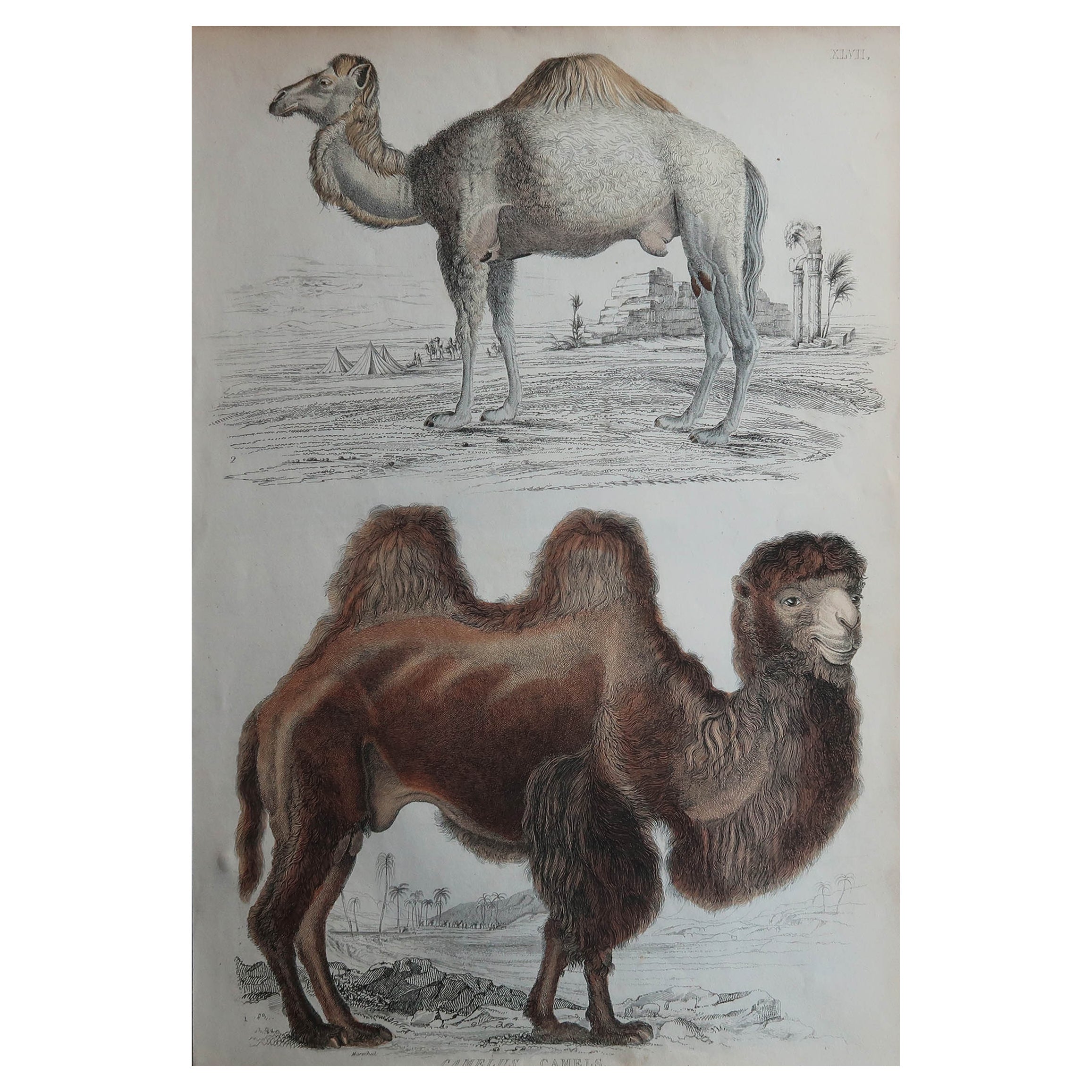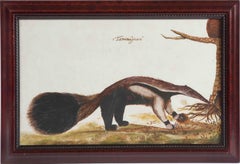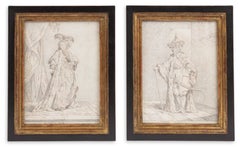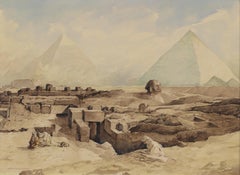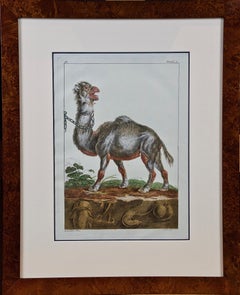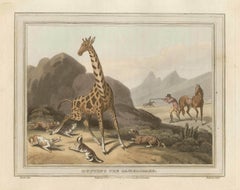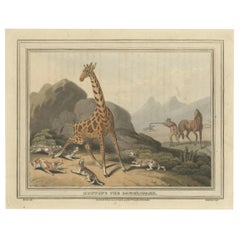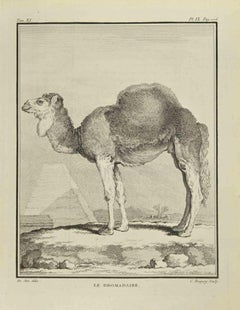Items Similar to The King's Camelopard
Want more images or videos?
Request additional images or videos from the seller
1 of 6
Charles Frederick de BrocktorffThe King's Camelopard1827
1827
$43,292.14
£31,511.87
€36,000
CA$58,924.97
A$65,911.28
CHF 34,300.62
MX$811,390.35
NOK 436,374.95
SEK 409,405.72
DKK 273,967.83
Shipping
Retrieving quote...The 1stDibs Promise:
Authenticity Guarantee,
Money-Back Guarantee,
24-Hour Cancellation
About the Item
Charles Frederick de Brocktorff (1775–1850)
‘Camelopard – a present from the Pacha of Egypt to the King – at Malta on its way to England’
Signed and dated C.F. de Brocktorff. / 1827. lower right, inscribed as titled in the painted margins lower centre. Pencil and watercolour heightened with gold paint and gum arabic on paper, 36.8 x 27.9 cm
A gift so majestic, it made kings blush, and a gift so grand, it would startle Europe into a craze. Pasha Muhammad Ali of Egypt (1805-1848) did it in 1827: he sent to Europe three magical spotted, horned creatures, each with a neck reaching the skies and legs as long as a house is high. One giraffe to King Charles X of France, one to Francis I of Austria and the most fabled one to King George IV of England. A curious sight for Europeans, who had not seen such a beast since the Medici giraffe in 1487.
Few animals created more of a stir in Europe than these royal gifts of giraffes from the Pasha. Perhaps Clara the one-month old rhinoceros which roamed the house of Dutch VOC Governor-General of Bengal, Jan Albert Sichterman (1692-1764), who had received her as a gift from the Nawab Shuja-ud-din-khan, governor of Bengal for the Great Mogul in Delhi. Clara was so sweet and tame that, to the great amusement of guests, she was allowed to run around the dining table. After two years she became too big and further damage to the house had to be prevented. In 1740, Sichterman gifted her to Douwe Mout van der Meer, enterprising captain of the Dutch ship the Knappenhof who took Clara to the Netherlands. Upon arrival in 1741, she caused a great sensation across Europe and became a royal favourite, commanding audiences among rulers as well as fascinated crowds. She even inspired a rage in Paris, where the wig-style à la rhinoceros came into vogue, and many poems were written about her. Also, many drawings and engravings, even coins with her depiction have survived. Clara died in London at the age of twenty.
Another famous animal was Hansken, a female elephant, born in 1630, taken to Europe by the VOC and gifted to Stadtholder Frederik Hendrik of Orange in 1633, in response to a request for exotic animals. Many paid significant sums of money to see Hansken, and her wide array of ‘truken’ or tricks, amongst them the curious Rembrandt van Rijn who sketched the fantastic beast multiple times. The elephant changed ownership quite a few times, becoming ever more valuable, but after visiting Hamburg, Copenhagen and Switzerland, she died in Florence in 1655.
In July of 1762, a Zebra arrived in England as a gift for Charlotte of Mecklenburg-Strelitz that would be known as the Queen's Ass. The striped beast was a wedding gift from Sir Thomas Adams to Charlotte because she had married George III a few months earlier. Because the zebra was unique, it was initially housed in the Tower of London. Several months later, in September, when a rare elephant arrived for the King, the two animals were housed together in the palace gardens. Although the creatures sparked great enthusiasm amongst the British, there was satire as well. The idea of an elephant and zebra being housed together seemed irresistible to some people. In fact, it resulted in a humorous penning of the following epigram:
Ye critics so learn'd, whence comes it to pass
That the elephant wise should be plac'd by an ass?
This matter so strange I'll unfold in a trice,
Some asses of state stand in need of advice
To screen them from justice, lest in an ill hour,
In the elephant's stead they be sent to the tower.
But the most famous magical creatures to come to Europe were the young Nubian giraffes for France and England. They were captured at the same time by Arab hunters in Sudan near the barren lands of Sennar. First, they were taken on a camel's back to the Blue Nile's shores, after which a felucca sailing boat transported them over this river to Khartoum where they boarded a specially constructed barge to Alexandria down the Great Nile. The shores were lined with people trying to catch a glimpse of these fantastic animals, which were accompanied by cows replenishing them each day with 25 litres of milk.
The giraffe for the English king caused a true 'giraffemania' at the time, dominating news, fashion, the arts and most important: satire. Often mockingly the French pointed out that the giraffe for the English King George IV did not have as long and prosperous a life as theirs and was consequently described less frequently in the century or more after. Indeed, caricaturists and satirists quickly associated the sickly giraffe with the ailing king.
The French Constitutionnel of July 3rd, 1872 recounts that two of the three giraffes reached the Pasha simultaneously, after which he offered them to the kings of France and England. "The Consuls of the two nations drew lots for their choice; the French consul had the good fortune to be favoured by chance, and his choice was a lucky one, for the Camelopard destined for the King of England is since dead." However, this account is wrong for this Camelopard was shipped to Malta where it over-wintered and was depicted by Charles Frederick de Brocktorff. In May it finally boarded the ship Penelope Malta to England, and it must have been a marvellous sight, for a hole was cut through the deck above the cargo hold through which the Giraffe could poke its neck.
The French giraffe was sent to France with an Arab groom named Hassan and a Sudanese boy named Atir. After a voyage of 32 days, she arrived in Marseilles on the 31st of October. It was feared that the journey around the Iberian Peninsula, up the Atlantic coast of France, and up the Seine to Paris would be too dangerous, so the decision was made that she should travel the 900 kilometres to Paris by foot. A good choice, since this probably strengthened the young giraffe and gave it many healthy years to come.
It over-wintered in Marseilles where it was charmingly provided with a two-part yellow coat and shoes to keep its feet warm. On May 20th, 1827 it set out to Paris, accompanied by Hassan and Atir, and of course the nourishing cows. The trip to the king took 41 days, with the passing-through of each village turning into a spectacle. From Aix-en-Provance to Avignon, Orange, Montelimar and Vienne the rage for the giraffe strengthened and word spread wide. Upon arrival in Lyon on June 6th, it was greeted by a crowd of 30,000 cheering people, all hoping to get a glimpse of the magnificent creature.
Finally, on the 9th July, it was presented to the king at the Château de Saint-Cloud. Standing nearly four metres tall, Zarafa as she was christened by an adoring novelist in the 1980s, truly caused a sensation and over a 100,000 people came to gawp, approximately an eighth of the population of Paris at that time. La mode à la Giraffe swept the nation; hair was elaborated in towering styles, and spotted fabrics became a craze. The famous Belle Africaine lived another 18 years in Le Jardin des Plantes in Paris, before passing away peacefully.
The English giraffe arrived in London by ship on August 11th, 1827, and was housed in the menagerie of King George IV, who is credited with establishing a private zoo at the Sandpit Gate of Windsor Great Park. His menagerie consisted of such exotic creatures as "wapiti, sambur, zebus, gnus, quaggas, Corine antelopes, llamas, wild swine, emus, ostriches, parrots, and waterfowl. There was also an 'enormous tortoise'." The showpiece of his collection, however, was the female Nubian giraffe, also called 'Camelopard' by the English. “The young specimen arrived along with several care-keepers and cows that provided her with milk as this one too was young, only 18 months old, and ten and a half feet in height”. She was the first Giraffe ever seen in England, and until she arrived there was a general belief that descriptions of the giraffe were partly fabulous.
George IV, often criticized by contemporaries for his exuberant lifestyle, was so enamoured with his camelopard, that he was often satirically depicted with it. One caricature showed the king seated astride a high-stepping giraffe accompanied by his mistress Lady Conyngham, wearing a straw hat with a wide curving brim and the lady a large bonnet, with two Nubians bowing. This satire alludes to the king’s ignorance of the problems of the country and the Camelopard being the talk of the town, as Lord Marlborough wrote to the Times after its arrival: "Everybody was so much engrossed by talking of the Camelopard who has just arrived, that nothing else seemed to be thought of."
The state of the giraffe was indeed the talk of the town because from the beginning there was trouble. An artist commissioned to paint the English giraffe's portrait now noticed that its lower limbs seemed deformed by injuries. Investigation revealed that on the stage of its journey from Sennar to Cairo on the back of a camel, the wounds had been caused because its legs were lashed together under the camel's body. After two years, it became very debilitated from those early wounds and exercise became painful and problematic. Someone came up with a plan to keep the animal moving, and a gigantic triangle on wheels was constructed in which "the creature was somehow secured each day and trundled round her paddock, the hooves just touching the ground."
Despite this kind treatment, giraffes are accustomed to Africa's warm and open savannah, not the cold and wet confines of a British zoo. Hence, two years after its arrival on the continent, the giraffe died, having grown only 45 centimetres in captivity. King George IV, obsessed with his giraffe, was terribly distraught over its death and commissioned the taxidermist John Gould to stuff his recently deceased pet. "The stuffer to the Zoological Society, Mr Gould, has had the performing of his duty… Soon after the Giraffe expired, De Ville, the modelist, was ordered down to Windsor, by His Majesty, and took a cast of the animal. From this cast a wooden form was manufactured, on which the skin of the animal is now placed, and which preserves its beauty to an extraordinary degree." (The Times, April 15, 1830)
Images of these royal giraffes are rare and sought after because they give a glimpse of a long-lost world of wonder and imagination. Nowadays a giraffe, or any other creature on the planet for that matter, is a mouse-click away. But images like the one presented might also make one pause for a second and realize how magnificent the natural world really is.
- Creator:Charles Frederick de Brocktorff (1775 - 1850, German, Danish)
- Creation Year:1827
- Dimensions:Height: 14.49 in (36.8 cm)Width: 10.99 in (27.9 cm)Depth: 0.04 in (1 mm)
- Medium:
- Movement & Style:
- Period:
- Condition:Laid down on a modern card mount. A small centimetre wide abrasion in the sky upper centre. Blues in the sky slightly faded. Some slight abrasions on the painted mount lower right corner.
- Gallery Location:Amsterdam, NL
- Reference Number:1stDibs: LU147128232942
About the Seller
No Reviews Yet
Vetted Professional Seller
Every seller passes strict standards for authenticity and reliability
1stDibs seller since 2021
- ShippingRetrieving quote...Shipping from: Amsterdam, Netherlands
- Return Policy
Authenticity Guarantee
In the unlikely event there’s an issue with an item’s authenticity, contact us within 1 year for a full refund. DetailsMoney-Back Guarantee
If your item is not as described, is damaged in transit, or does not arrive, contact us within 7 days for a full refund. Details24-Hour Cancellation
You have a 24-hour grace period in which to reconsider your purchase, with no questions asked.Vetted Professional Sellers
Our world-class sellers must adhere to strict standards for service and quality, maintaining the integrity of our listings.Price-Match Guarantee
If you find that a seller listed the same item for a lower price elsewhere, we’ll match it.Trusted Global Delivery
Our best-in-class carrier network provides specialized shipping options worldwide, including custom delivery.More From This Seller
View AllAnimal painting of a 'Tamanuâguacû (Ant-eater)' late 17th/18th century, Brazil
Located in Amsterdam, NL
Follower of Zacharias Wagener (1614-1688)
Tamanuâguasû (Giant Anteater)
On Italian 17th or 18th-century paper, H. 28 x W. 43.5 cm
The present painting is a copy after Wagener’s painting of the anteater, Tamanduá-bandeira, which is illustrated in his “Thier Buch”, with 109 drawings of Brazilian fish, birds and mammals, published in Amsterdam c. 1641, in German.
Zacharias Wagener, or Wagenaer in Dutch, (Dresden 1614 – Amsterdam 1668) was a real adventurer who became Opperhoofd on Deshima and Governor of the Cape of Good Hope in the service of the VOC. During the Thirty-Year War in Germany Wagener tried his luck in Amsterdam where he worked for the map-maker Willem Blaeu. In 1634 he joined the WIC and left for Dutch Brazil where he worked as writer and painter, together with Frans Post...
Category
Early 18th Century Old Masters Animal Drawings and Watercolors
Materials
Paper, India Ink, Gouache
Costume drawings for ‘Ambassadeur de Siam’ and ‘La Sultana Reine’
Located in Amsterdam, NL
Joseph-Marie Vien (1716-1809)
‘Ambassadeur de Siam’ and ‘La Sultana Reine’
Both titled lower centre, the drawing of the ambassador inscribed with colours intended for the prints, e...
Category
Mid-18th Century Old Masters Figurative Drawings and Watercolors
Materials
Paper, Pencil
Devotion in the Dessert near the pyramids of Gizeh, circa 1919
By Marius Bauer
Located in Amsterdam, NL
Marius Bauer (1867-1932)
‘Devotie in de Woestijn’ (Devotion in the Dessert near the pyramids of Gizeh, circa 1919)
Signed lower right and titled lower left
Watercolour on paper, H...
Category
Early 20th Century Impressionist Landscape Drawings and Watercolors
Materials
Paper, Ink, Watercolor, Pencil
A pair of Indonesian Landscapes, by Charles Legrain (19th century)
Located in Amsterdam, NL
Charles Legrain, (19th century)
Two Javanese landscapes
Both signed Legrain Ch. and one dated 1857
Both oil on canvas, size: 95 x 114 cm
In rich gilt-gesso frame.
(2x).
Category
Mid-19th Century Romantic Landscape Paintings
Materials
Canvas, Oil
European Artist - Indonesian Portraits of Mas Marco Kartodikromo, 1890-1932
Located in Amsterdam, NL
European artist (early 20th century)
Two study portraits of Mas MarCo Kartodikromo (1890-1932)
One inscribed Kartodikromo lower right
Framed in ebonized frame with white mount.
Pe...
Category
Early 20th Century Romantic Portrait Drawings and Watercolors
Materials
Paper, Crayon
Study of a dog
Located in Amsterdam, NL
Study of a dog
Oil on paper laid down on panel, 17.5 x 25.5 cm
Provenance
Private collection, the Netherlands
Note:
We are grateful to Mr Fred Meijer for his attribution to Ludolf de Jongh
Ludolf de Jongh was the son of a shoemaker. When his father moved to Rotterdam, the young Ludolf decided to learn art rather than shoemaking and became a pupil of Cornelis Saftleven. Later he studied under Anthony Palamedes in Delft and still later with Jan van Bijlert in Utrecht.
In 1635 he travelled to France with Francis Bacon. Seven years later, in 1642, he returned to the Netherlands when he heard that his mother had fallen ill. He set up a shop in Rotterdam, and his earliest signed paintings date from that year.
According to Houbraken, his travels had caused him to speak French so fluently, that his parents had to learn French in order to speak with him.
De Jongh’s work shows a strong influence from the Utrecht school of Caravaggio admirers, especially Jacob Duck...
Category
Mid-17th Century Old Masters Animal Paintings
Materials
Paper, Oil, Wood Panel
You May Also Like
18th Century Hand Colored Engraving of a Camel from Pennant's " British Zoology"
Located in Alamo, CA
An 18th Century Hand Colored Engraving of a Camel from Thomas Pennant's famous publication on natural history "The British Zoology, Published under the Inspection of the Cymmrodorion...
Category
1760s Naturalistic Animal Prints
Materials
Engraving
Hunting the Camelopard (Giraffe), antique African hunting engraving print, 1813
By Samuel Howitt
Located in Melbourne, Victoria
Colour aquatint after Samuel Howitt (1756/7-1822).
From Samuel Howitt's 'Foreign Field Sports' Samuel Howitt was an English painter, illustrator and etch...
Category
Early 19th Century Naturalistic Animal Prints
Materials
Aquatint
Old Hunting Scene of the 'Camelopard', a Name Often Used for a Giraffe, 1813
Located in Langweer, NL
Antique print titled 'Hunting the Camelopard', the Giraffe was often called the camelopard.
This print originates from Samuel Howitt's 'Foreign Field Sports'.
Artists and Engr...
Category
Antique 1810s Prints
Materials
Paper
$250 Sale Price
20% Off
Le Dromadaire - Etching by Jean Charles Baquoy - 1771
Located in Roma, IT
Le Dromadaire is an etching realized by Jean Charles Baquoy in 1771.
It belongs to the suite "Histoire Naturelle de Buffon".
The Artist's signature is engraved lower right.
Good c...
Category
1770s Modern Figurative Prints
Materials
Etching
$252 Sale Price
25% Off
Large Original Antique Natural History Print, Camels, circa 1835
Located in St Annes, Lancashire
Great image of camels
Unframed. It gives you the option of perhaps making a set up using your own choice of frames.
Lithograph after Cpt. Brown and Marechal with original hand colo...
Category
Antique 1830s English Folk Art Prints
Materials
Paper
Camel - Drawing by follower of Stefano Della Bella - 18th Century
By Stefano Della Bella
Located in Roma, IT
Camel is an artwork realized in the 18th Century by an artisti follower of Stefano della Bella.
Pencil Drawing.
The artwork is in good conditions .
The artwork is depicted skill...
Category
18th Century Old Masters Drawings and Watercolor Paintings
Materials
Pencil
$1,083 Sale Price
25% Off
More Ways To Browse
King And Queen Art
Frederick The Great
King Charles Painting
Shoe Drawing
Zoo Animal
Modes De Paris
African Animal Drawings
Animal Camel
Gold Bengal
Dead Animals
Medici Gold
Charles Belle
Antique Cold Frame
Watercolor Cow
Pencil Animal Sketches
Netherlands Painting Early 20th Century
Large Gold Elephant
French Chateau Watercolor




